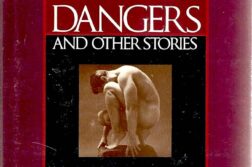TO WHAT EXTENT did Walt Whitman consciously pitch his books to men who were attracted to other men? We know that he carefully crafted his public persona in general, right down to writing pseudonymous reviews and letters that praised his books but also focused on his character and appearance.
This studied presentation extended to the physical look of Leaves of Grass: all editions authorized by the living Whitman featured his photograph. Whitman designed the frontispiece for the first (1855) and second (1856) editions himself, which featured an engraving of a daguerreotype adorned with additional shading. The caption reads “Walt Whitman from life,” instructing the reader to see the photo as the authentic Whitman. In the photograph, the poet stands at ease in shirtsleeves and workman’s jeans, one hand on his hip and one in his pocket, his collar open, his hat raked, and his shirt open to a flash of flannel undershirt. His casual stance announces freedom from formality and comfort with outdoor work. The neat trim of his beard and the spotlessness of his clothes reveal, however, that Whitman has pitched a calculated performance. He’s a dandy playing at working. This poet, this photograph says, refuses the usual dichotomy between the manly workman and the effete æsthete. This poet has it all.
From the very first review of Leaves of Grass by Charles Henry Dana in the July 23, 1855, issue of The New York Daily Tribune, this photo was prominently mentioned. Dana begins his review by noting that “From the unique effigies of the anonymous author of this volume which graces the frontispiece, we may infer that he belongs to the exemplary class of society somewhat irreverently styled ‘loafers’ … [He is] in a garb, half sailor’s, half workingman’s, with no superfluous appendage of coat or waistcoat, a ‘wideawake’ perched jauntily on his head, one hand in his pocket and the other on his hip, with a certain air of mild defiance, and an expression of pensive insolence in his face which seems to betoken a consciousness of his mission as the ‘coming man.’”

These instructions demand that the viewer see both Whitman’s adherence to and difference from conventional masculinity. Dana describes Whitman as a “loafer,” the kind of man who is often associated with a refusal to exhibit the proper masculinity, a cynical man-about-town, perhaps, or even a man of questionable sexual activity. Whitman’s insolent pose combines signals of hyper-manliness—“half sailor, half workingman”—and conscious posing in a way that is familiar to both contemporary gay men and drag kings—to anyone whose appreciation of the æsthetics of masculinity has caused him or her to consider how to best perform its socially approved manifestations. To me, Whitman here looks more like he’s dressing up a night out in the bars than for an actual job as a sailor or workman, and that bit of undershirt peeks out with intent. He’s tough enough to be hot, but not so tough that he’s unapproachable. Sound familiar?
Contemporary reviewers returned to this photo as a way to read both the poet and his poems. The anonymous writer of a review of Leaves of Grass in the September 15, 1855, Brooklyn Eagle conflates Whitman, his book, and his photo early on: “[The] author is Walter Whitman, and the book is a reproduction of the author. His name is not on the frontispiece, but his portrait, half length, is. The contents of the book form a daguerreotype of his inner being, and the title page bears a representation of its physical tabernacle.” In other words, the poem and the photo are both equal to the poet’s soul, and both can be used to understand him.
This same reviewer reprinted from Song of Myself the famous tale of the voyeur watching the “Twenty-eight young men bathe by the shore;/ Twentyeight young men and all so friendly…/ Which of the young men does she like the best?/ Ah, the homeliest of them is beautiful to her.” Here, Whitman cloaks same-sex desire in a heterosexual guise; he does not add the more straightforwardly homoerotic Calamus poems until the third edition, in 1860. Here the sex of the voyeur is less important than the (male) poet’s expression of lust for the male form; the voyeur goes so far as to imagine “An unseen hand also pass’d over their bodies/ It descended tremblingly from their temples and ribs.” If this graphic image (one of the passages that contemporary critics wanted to censor) doesn’t speak to men who desired other men in the mid-19th century, then what did?
Whitman himself took no chances that his reviewers would not pay proper attention to his body in the “anonymous” reviews he wrote himself. In the September 1855 United States Review, he begins by noting his own masculine appeal: “An American bard at last! One of the roughs, large, proud, affectionate, eating, drinking, and breeding, his costume manly and free, his face sunburnt and bearded, his posture strong and erect.” The reviewer waxes on that these poems are “fit for men and women with the attributes of throbbing blood and flesh. The body, he teases, is beautiful. Sex is also beautiful. … Sex will not be put aside; it is a great ordination of the universe. He works the muscle of the man and the teeming fibre of the female throughout his writings.” Surely the ears of any proto-gay man who read this auto-review, would be at full attention by now.
The ability of critics to see how this photo and other publicity spoke to gay readers has evolved with the acceptance of homosexuality in recent decades. This trajectory can be followed through Whitman’s biographers. Gay Wilson Allen, whose 1955 article, “Dual Images of Walt Whitman,” was the standard for more than forty years, writes that Whitman’s “face [in the photo]is not that of ‘one of the roughs,’ neither crude nor sensual, but refined and even slightly resembling traditional images of Christ.”* Allen recognizes the complex registers of masculinity in the photo, but interprets their repudiation of the masculine standard as asexual rather than as homosexual.
By contrast, Jerome Loving in Walt Whitman: The Song of Himself sees in the photo “a man with a carnal appetite already whetted by experience” but doesn’t register the photo’s treatment of manliness as specifically homosexual, a reading that parallels the rest of his 1999 biography, which is happy to sexualize but reluctant to homosexualize Whitman. And Vivian R. Pollak, who in The Erotic Whitman (2000) views Whitman’s ideal of inclusiveness as inspired by his attempt to make a public space for his sexual orientation, uses a close-up of the engraving as the cover of her book.
This multiplicity of interpretations is perhaps a tribute to Whitman’s ability to create a photo that could pass muster with a 19th-century readership but still reach out to same-sex-oriented men in a very special way. In either case, Whitman’s sexualized self-presentation clearly points the way to a “different” kind of masculinity. Whitman was not only conscious of himself as an erotic figure but also eager to present himself homoerotically and appeal to men who desired other men, and to guide these men to the twenty-ninth bather, the Calamus poems, and other work that express their desires. The photo therefore acted as a kind of double agent, signifying rebelliousness to a broad audience but a more specific brand of it to a subset of men that he regarded as brothers.
Jeff Solomon is a visiting professor of English at St. Olaf College.





